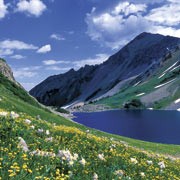With its splash of Hollywood glamour and upscale ski resort couture, Aspen years ago inherited the sobriquet “Glitter Gulch.” Paparazzi stalk Aspen hot spots like Caribou Club for sightings of Kevin Costner, Kurt Russell or other stars who make the Rocky Mountain resort their second home. In its downtown core, boutiques bearing names like Christian Dior rub shoulders with top-tier restaurants and chichi day spas.
Beneath its glitzy exterior, though, lies a colorful past. For Aspen, all that glitters has not been gold. Well over a century ago, Ute City (Aspen’s former name) was founded as a silver mining town, and by 1893 saw its population swell to over 12,000. A year later its Smuggler Mine churned out the largest nugget of pure silver ever mined, topping 2,000 pounds.
But by then silver mining was on the wane and Aspen slipped into a deep slumber until the end of WWII when Chicago industrialist Walter Paepcke helped found the Aspen Skiing Corporation (now Company). The company now runs Aspen Mountain, Aspen Highlands, Buttermilk, and Snowmass, comprising 341 ski trails, which all contribute to the town’s reputation as a ski mecca.
Aspen’s setting in the Roaring Fork Valley is ideal.
“The surrounding mountains are truly majestic,” says Helen Klanderud, mayor of Aspen from 2001 to June 2007.
Klanderud moved to Aspen in 1971 with four small children in tow.
“That was a different time. A lot of people were dropping out and coming to places like Aspen to live an alternative lifestyle” she says. “They came to enjoy the outdoors, Aspen’s small-town character and quality of life.”
During that era, one of its most flamboyant residents, Hunter S. Thompson, nearly became sheriff of Pitkin County, running on the Freak Power Party platform, in favor of decriminalizing drugs.
Though its eccentricities are now more subdued, Aspen retains a vital arts culture. At the forefront is Paepcke’s Aspen Music Festival and School, a training ground for musicians as well as coordinator of a nine-week summer festival featuring more than 350 classical music events.
“Summer is really the explosion of arts events,” Klanderud says. Other summer happenings include the five-week Aspen Dance Festival, presented by the Aspen Santa Fe Ballet, and the Jazz Aspen Snowmass June Festival.
Though the face of Aspen has transformed, with pricey properties and exclusive shops, the town is anchored by its historic architecture. One of Aspen’s oldest buildings, the Hotel Jerome, was originally constructed in 1889 during the silver mining boom.
According to Klanderud, the Aspen population has grown older over the years, but younger generations are beginning to discover all it has to offer.
“We brought the community back in a variety of ways,” Klanderud says, primarily through negotiations between the Aspen Skiing Company and ESPN to host the annual Winter X Games in Aspen. “That gave us a shot in the arm.”
Groups are also getting more attention. In June the Aspen Meadows Resort, home to the Aspen Institute, opened a 22,000-square-foot meeting space, the Doerr-Hosier Center.
Nearby, Snowmass is also planning a 15,000-square-foot conference space at its base village, as well as 64,000 square feet of new shops and restaurants, a community aquatic center and a 246-unit conference hotel, the Little Nell at Snowmass.
Despite all the years of change, for Klanderud Aspen has not lost its soul: “I can’t describe it. There is something magical about this place.”







